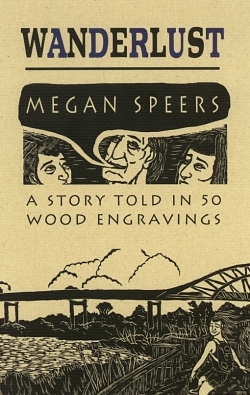Wanderlust
- 2010 INDIES Finalist
- Finalist, Graphic Novels & Comics (Adult Nonfiction)
With Wanderlust, the masters in art book production at Porcupine’s Quill have trained a spotlight on another talented craftsperson. In this third in their series of wordless novels edited by the notable George A. Walker, award-winning printmaker Megan Speers combines talent in both carving and storytelling to create an optimistic and enjoyable book.
A wordless novel, told in pictures, necessitates that its readers tell the story to themselves; what follows both hews to and creates anew an oral tradition. A certain universal accessibility is produced as Speers allows a simple tale to speak for itself through symbols, interpreted in the language and experience of the reader (and perhaps, even the woodcuts themselves could serve as a tangible document for those to whom images are not accessible). Here, even dialogue balloons themselves contain images, and an interesting mise en abîme effect is produced.
The degrees of detail and texture betray an enormous amount of work and care taken in producing the series of fifty woodcuts that narrate this piece. It’s interesting to note that Speers would spend such time working (presumably) in one place in order to depict a tale about motion: it seems to be a subject close to the artist’s heart. The archetypal nature of the story, which includes various small town punk life landmarks, (e.g., being broke, dumpster diving, and enjoying time spent with friends) is rendered in a medium that reads as permanent, the deep black ink serving to solidify the images.
Relating such varied experiences as targeting and brutality at the hands of police, or cruising on a skateboard down an open path on a breezy, sunny day, Speers explores both the light and dark sides of life. Still, these panels depict some of the happiest moments of camaraderie in the pitch of night, and in so doing break down that very binary.
Speers’s style is clearly influenced by contemporary graphic art and animation, and includes a variety of frame/cell sizes, creative use of depth of field, and is filled with emotional resonance. It would fit in well next to Liz Baillie’s My Brain Hurts on the bookshelf of anyone who identifies with newfound joy in autonomy—particularly those who appreciate the prototypical black and white punk aesthetic. Each of these woodcuts is a singular work of art, and Wanderlust is a very pleasing read.
Reviewed by
Patty Comeau
Disclosure: This article is not an endorsement, but a review. The publisher of this book provided free copies of the book and paid a small fee to have their book reviewed by a professional reviewer. Foreword Reviews and Clarion Reviews make no guarantee that the publisher will receive a positive review. Foreword Magazine, Inc. is disclosing this in accordance with the Federal Trade Commission’s 16 CFR, Part 255.

